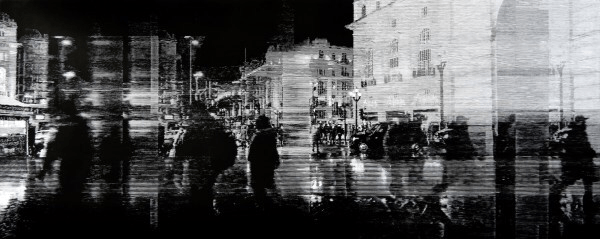
Spear’s sends along it’s own,’printmaker by trade’, cover artist Adam Dant to seek out his favourite ‘hot off the press’ recommendations.
In India printmaking is known as ‘Graphic Design‘. I learned this typically ‘Hobson-Jobson‘ taxonomic Imperial throwback when I arrived at M.S University Baroda in Gujarat and was handed a plank of wood and a chisel rather than the type-scale and magazine page layout style guide I’d expected as a ‘Graphic Design’ exchange student. The letter of invitation my professor had opened was in the wrong pigeonhole at Liverpool School of Art .
After several months in the ceiling fan cooled print workshops of professor Rini Dhumal , herself a student of legendary print pioneer Stanley William Hayter, I soon realised and still believe that I had discovered one of the most extraordinary and complex conduits for artistic expression.
I became hooked on printmaking.
The methods and media of printmaking embody so much more in their essence than other forms for artistic expression. Printmaking is a discipline and technology both resistant and yielding. It’s a methodology that has a serious lineage
Printmaking physically and conceptually connects our own artists to 500 years of creative output by their predecessors, at the same time as fostering the deployment of the most up-to-date technologies of our age. The London Original Print Fair provides singular exemplars of each.
For the general art lover, who has probably never found themselves in the same room as an ‘aquatint box‘ or holding a ‘flapper’ (though maybe some Spear’s readers can lay claim to the latter) the world of print media is slightly opaque. It’s often said of printmaking that ‘the problem with printmaking is printmaking’.
A museum curator I’d asked to write a catalogue essay on a print exhibition for me said that.
I still wonder quite what they meant, but I imagine that it’s a thought that comes from never having been handed a plank of wood and a chisel and been told to get on with it.
Here are some of the prints which caught my ‘printmakers’ eye at this years London Original Print Fair.
Taking the most ‘rudimentary’ medium of woodblock printing to the top of Gotham’s skyscrapers, Sadie Tierney’s compelling interpretations of the well-worn sight of The Chrysler and Empire State buildings display an ease of expression which really embodies that exciting jolt of surprise everyone gets when confronted by majestic Manhattan for the first time.


Her prints are colourfully and selectively ‘inked’ in a fashion according to the changing light viewed from her vantage point atop the Rockerfeller Centre, making each a unique prospect of Manhattan over the course of a working day.
The deep white lines that define the shapes and cursory detail of New York’s sentinel landmarks are achieved using the same kind of ‘drilling’ tool on her woodblocks that the builders in that famous black and white photo who sits in a line on high rise girder eating their packed lunches would have used.
The same medium of woodcut printing or ‘relief printing’ (whereby the raised surface of a sheet of timber, areas of which the artist wishes to remain blank, revealing the paper between the ‘inked image has chiseled’ away) can, as Sadie Tierney’s prints are testament, reveal the most rudimentary qualities of printmaking as an art form .
The very same printmaking technique in the chisel wielding hands of ‘Katsu’ Yuasa, combined with a similarly super-urban theme in the case of his depiction of Piccadilly Circus, on show at Tagfinearts, provide very different results in black and white.
Famous for his meticulous transcription of black and white photographic imagery into immaculately realised woodblock prints, precise, linearly incised horizontal cuts, like an old school TV picture, Katsutoshi’s latest woodcut print views a very viewed view, Piccadilly Circus, just around the corner from the RA print fair. Via Katsu’s print process the very familiar and recognisable becomes strange and alien.
While I was a student of printmaking at the Royal College Art, Margaret Thatcher was just about to leave number 10 and I remember my then tutor Chris Orr telling us students how he’d had his knuckles rapped for sketching in the house of commons strangers gallery.
Chis Orr continues to engrave in knuckle-rappingly good fashion. His very latest print depicts the same barking and bawling residents of ‘the commons‘ that he also showed us in animal form in his, Times Newspaper Ad pre-emptive visualisation, ‘The Mother of all Parliaments‘ print.
His latest black and white print is titled ‘the parliament of the long noses‘ and the noses are very long.
Everyone’s got one and none of them are nice. Diane Abbott’s schnozz rests on the Labour leaders head and Boris Johnson’s nose is the biggest of them all‘.
The spirit of Spear’s magazine’s guardian angel, the 18th century visual satirist James Gillray is present and like the perennial imperatives of the press deadline Chris Orr states of his work that‘ immediacy has been my driving force’.
We, and Chris Orr, hope that the world depicted in these particular prints will be superseded by something better.

Per square inch, in terms of volume of printers ink and intensity of colour Hugie O Donoghue’s conjuring up of our favourite intese’ painter, Vincent Van Gogh, in print is superlative, beautiful, astonishing. Everything everyone loves about Vincent, his grizzled features in bright yellow, his cloyingly pleading but beautiful letters, his sharp, jabby primative ink sketches and Van Gogh’s general presence, whether via William Dafoe, Jacques Dutronc or Kirk Douglas or even the self-portraits of the man himself are all saluted in O’Donoghue’s beautifully executed , exhaltant and satisfyingly textured carborundum intaglio prints.
Unlike Van Gogh the man, the wretch, the master, the creator whose presence so many gallery goers seek succor from via personal contact with his works, the astonishing new prints by Anish Kapoor that greet visitors on arrival at the London original print fair, both elevate and eliminate the cultish/Van Gogh-ish presence of’ the artist’ in a deft ‘printerly’ fashion.




By depicting and transforming the hallucinatory qualities of contemplating a single colour, (in this case yellow,) via the ‘digital medium (‘a computer’) and eventually the process of printing (polymer gravure) according to the age-old practice of opening a tin of rich and livid printing ink, Anish Kapoor creates not only a three dimensional space from 2D materials in which to experience his actions whereby the artist is essentially a ‘God’, but in doing so he suggests the negation of the need for artists in general. Colour exists without artists as do rods, cones and opthalmologists. In Kapoor’s hands (or those of his very skilled, usually overlooked print technician) ‘colour’ is the only thing.
Anish Kapoor’s new prints are a fantastic vivid and cleansing punctum, an enervating eye-wash? For ones arrival and departure at what I think is the most visually and intellectually fulfilling art fair of the year in London.
If you haven’t immersed yourself in the world of printmaking before, this is the place to start. I can guarantee that you’ll soon be hooked.
The London Original Print Fair runs until the 28th April 2019 at The Royal Academy of Arts, London
Adam Dant is an artist and illustrator of Spear’s covers












